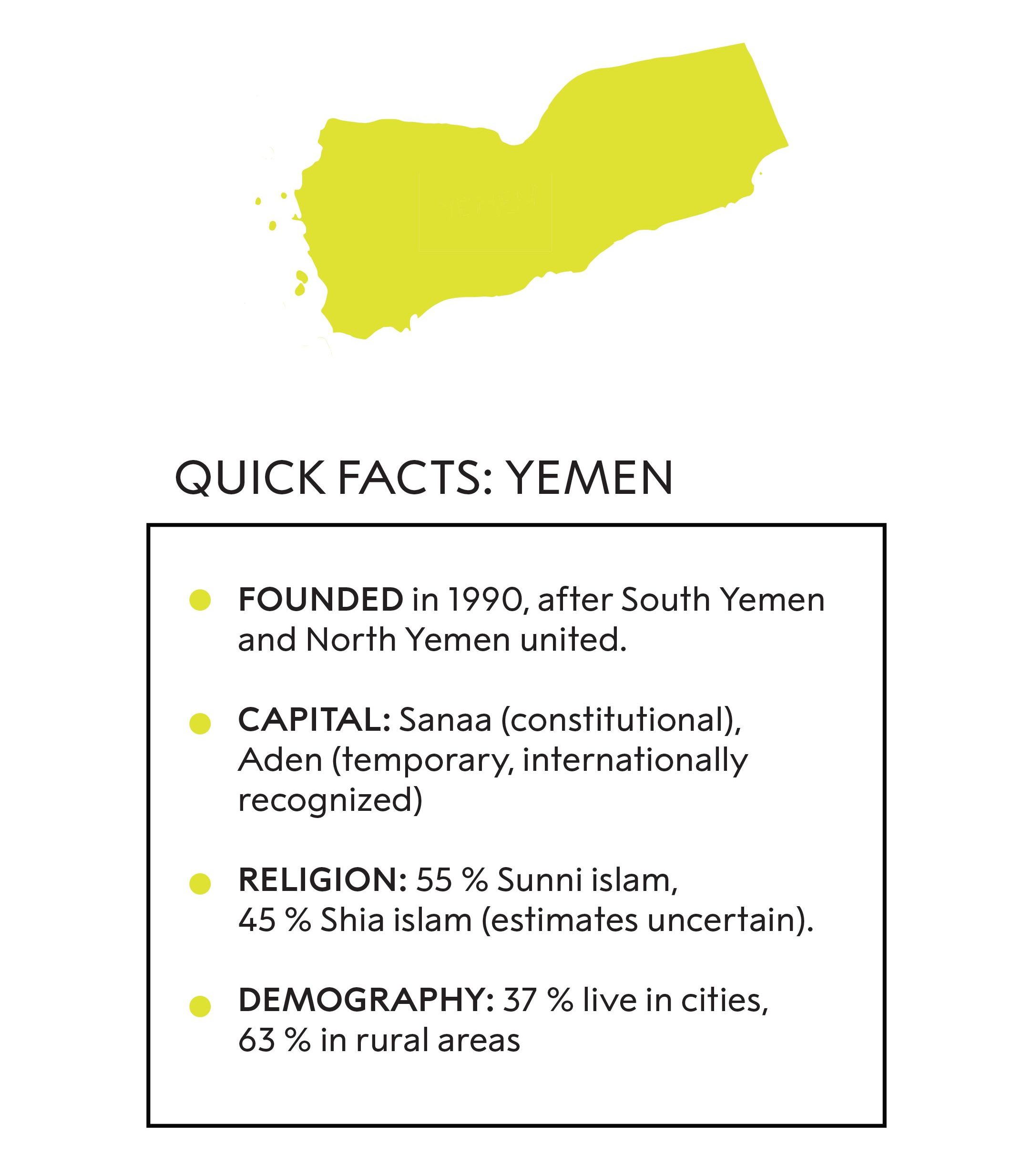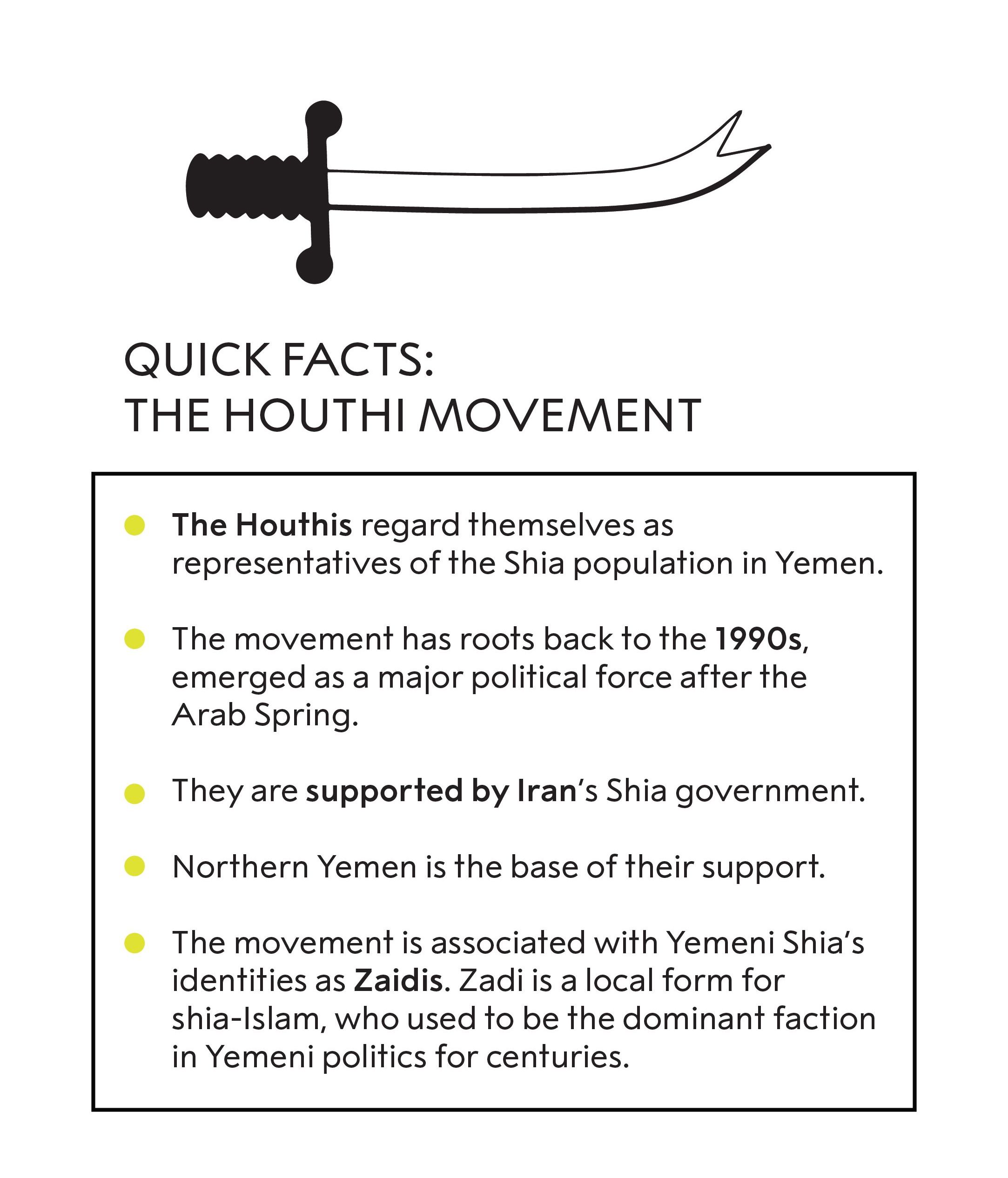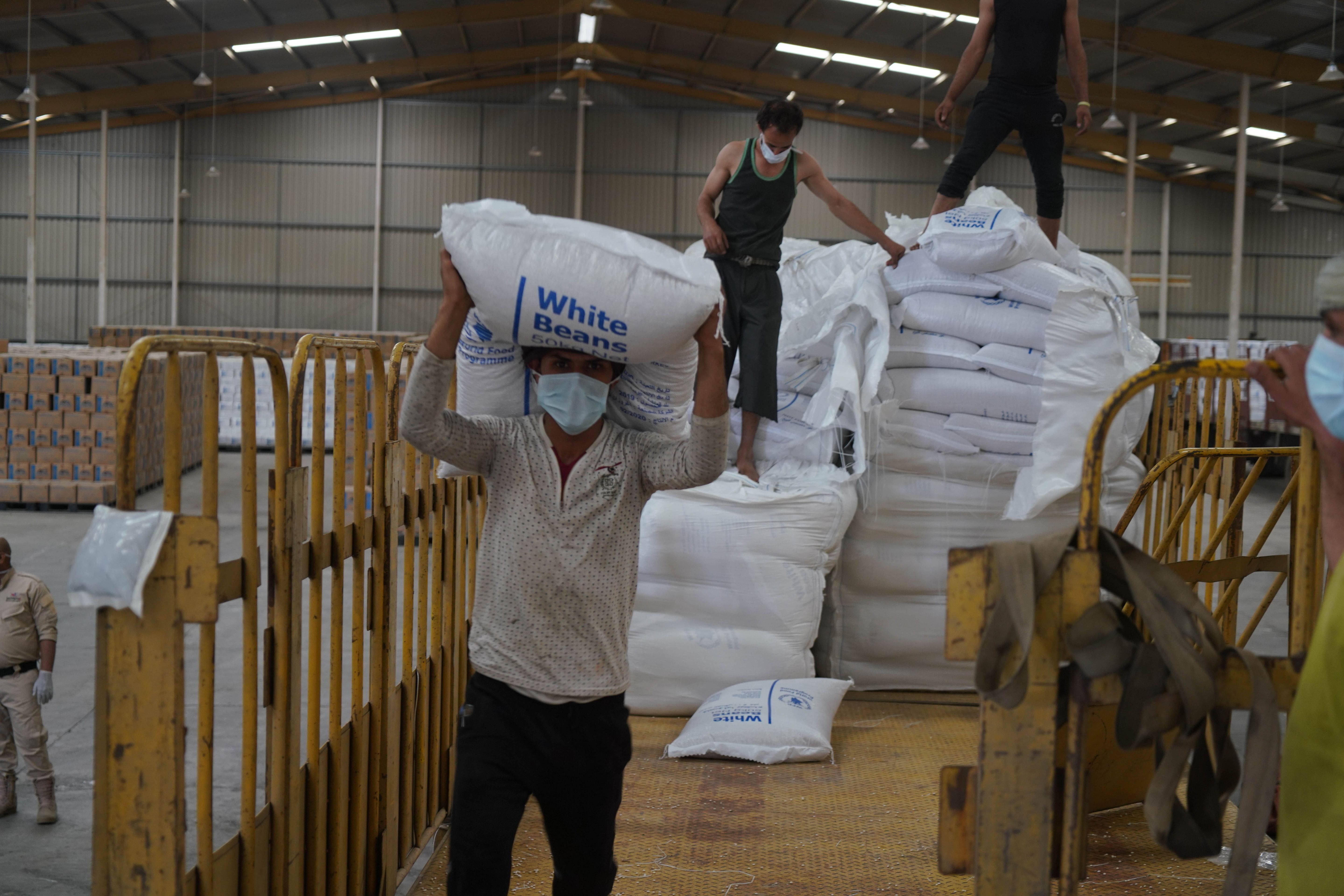Yemen - Road of Glory
Since war broke out in 2014, thousands of civilian lives have been lost, and 3.65 million Yemenis are now refugees in their own country. Blockades and bombings of supply lines and infrastructure has led to a lack of food and clean water for millions of people. Today, less than half of the population has secure access to food.
What are the causes of this dire situation? And why is the conflict seemingly so difficult to solve?
The Yemen war is complex. Identity, economic inequality, lack of democracy, and meddling by foreign powers, are only a few of the factors shaping this long-lasting crisis.
An important trading post
Due to its fertile land and its strategic location along the trade route from Asia to Europe, Yemen has been a sought-after location for regional and global actors throughout history. In the beginning of the 20th century, the country was split in half. Northern Yemen eventually became independent from the Ottoman Empire, while Southern Yemen continued under British rule. It was not until 1990, after decades of internal struggle and outer pressures pulling the country in different directions, that Yemen was united under a single government.
The disintegration of a state
It was the liberation hero Ali Abdullah Saleh, who had governed North Yemen since 1978, who became the united Yemen’s first President in 1990. Saleh had close ties to the West, and eventually became an ally to the American “war on terror” in the 2000s.
When the Arab Spring reached Yemen in 2011, the protestors demanded Saleh’s resignation, which he did in February of 2012. His replacement, Abed Mansour Hadi, was more closely associated with southern Yemen, and had a more explicit Sunni Muslim image.
Hadi was not a popular choice among Saleh’s allies or the Shia population, and the Shia-based Houthi-movement saw rapid growth. Almost half of Yemen’s population is Shia, and the Houthis viewed themselves as the primary proponent of Shia interests in Yemen.
Shifting alliances and competition for governing power
The Houthis joined forces with Saleh and his allies – former adversaries of the Houthis – in order to defeat a common enemy – the new President Hadi. In 2015, the Houthis took control of the Capital, Sanaa, and still control the city to this day. However, Hadi and his government, based in the southern port city of Aden, is currently the internationally recognized government.
While it is probably appropriate to call the conflict a civil war, the Yemen crisis cannot be understood without examining the foreign actors influencing and shaping the conflict.
In parts of southern Yemen, a third major government, the Southern Transition Council, has taken control of larger areas. Al-Qaeida is also a political force in Yemen and control their own areas. Meanwhile, there are a number of smaller regional, semi-autonomous governments with differing and fluctuating interests, and the alliances that exist in the Yemen conflict are generally tenuous and tend to change over time.
An “international civil war”?
When the Hadi government asked for international aid in their fight against the Houthis, the conflict escalated, and became a part of the contest between the two major regional powers, Saudi Arabia and Iran.
Ever since, a coalition of countries, led by Saudi Arabia, has backed up the Hadi government and contributed militarily to the fight against the Houthis. The coalition has also received support from western powers, such as the US and the UK. The Houthis have received most of their support from Iran, and are viewed as an Iranian proxy force competing with Saudi Arabia for influence.
A lush and fertile land
The war and the many bombings in Yemen have brought widespread human suffering and displaced millions of people. Food production and distribution has been devastated, and many Yemenis live in acute food insecurity, relying on food aid.
However, it has not always been like this.
Originally, Yemen was well suited for agriculture. The climate is more humid and enjoys more rainfall than most of the Arabian Peninsula. The country has been self-sufficient with food through most of its history.
After the war broke out, food production became a military target. Agriculture has been one of the hardest-hit sectors of the Saudi coalition’s air strikes. This has driven farmers away from their lands, and critical infrastructure and supply lines have been destroyed.
It is a common conception that the weather plays an important role in famines and starvation events, and floods and droughts are often assumed to play key roles. This, however, is a faulty, or at least exaggerated, assumption. While the weather can contribute to starvation, most famines are caused by political and military decisions.
Economics pressures, blockades, corruption, and illegal sale of food aid are just some examples of how politics has affected the food situation in Yemen and made the country dependent on food aid from abroad.
The World’s largest humanitarian operation and the WFP
Emergency relief in Yemen has only gotten more difficult as the conflict has evolved. Over the past year, the pandemic has further complicated aid operations, and made the political situation ever more precarious.
All parties to the conflict exploit emergency relief for their own gain. This is done by withholding permits for aid projects in “disloyal” areas, seizing food and other aid resources, as well as other methods. Emergency relief in Yemen has become highly politicized and weaponized.
The World Food Programme is heavily involved in Yemen, and a large proportion of the population depends on the WFP. 80 % of the Yemeni population is reported to depend on some form of humanitarian relief, and an approximated 16 million people depend on food aid.
Much of the aid comes in the form of medical aid and food, but where markets are stable enough, WFP instead gives out a sum equal to 12 USD per month, per person. Giving cash directly keeps the local economy running, and strengthens local producers and distributors of food.
In January 2021, WFP’s work was made even more complicated. In the last days of the Trump-administration, the United States designated the Houthis a foreign terrorist organization. This makes it more difficult to deliver food and cash to civilians in Houthi-controlled areas.
"[The designation] is literally going to be a death sentence to hundreds of thousands, if not millions of innocent people in Yemen. "
Only one thing seems certain at this point: The war in Yemen – and the suffering it brings – is still far from over.
The 2020 Peace Prize Exhibition
With this year’s Peace Prize exhibition, the Nobel Peace Center sought to highlight how food was used as a tool for power in conflict. Yemen is one of the most recent examples of how food is used for political and military gain, and how civilians are forced to suffer the consequences.
The image Road of Glory is Peace Prize photographer Aïda Muluneh’s interpretation of the humanitarian disaster in Yemen. Road of Glory is one of ten photographs that seeks to capture a historical moment where food has been used as a tool for power in conflict.
The picture is taken in an abandoned building in Abidjan, Cote D’Ivoire, where Aïda Muluneh lives and works. An old grafitti piece on the wall reads “Route à Gloire”, which means “The Road to Glory” in French. This became the title of the photo, as Muluneh found it an apt description of the situation in Yemen: both sides fight for power and glory, while the war itself is becoming a road to ruin for the nation.
Muluneh grew up in Yemen’s capital Sanaa, and has vivid memories about the city’s life and colours. As such, this picture is particularly personal to her, and when she was tasked with creating this year’s Peace Prize exhibition, Yemen was the first country that came to mind.
The exhibition is supported by Yara International (Nobel Peace Prize Celebration Partner 2020), Canon (print partner) and Bergesenstiftelsen.
Share:






